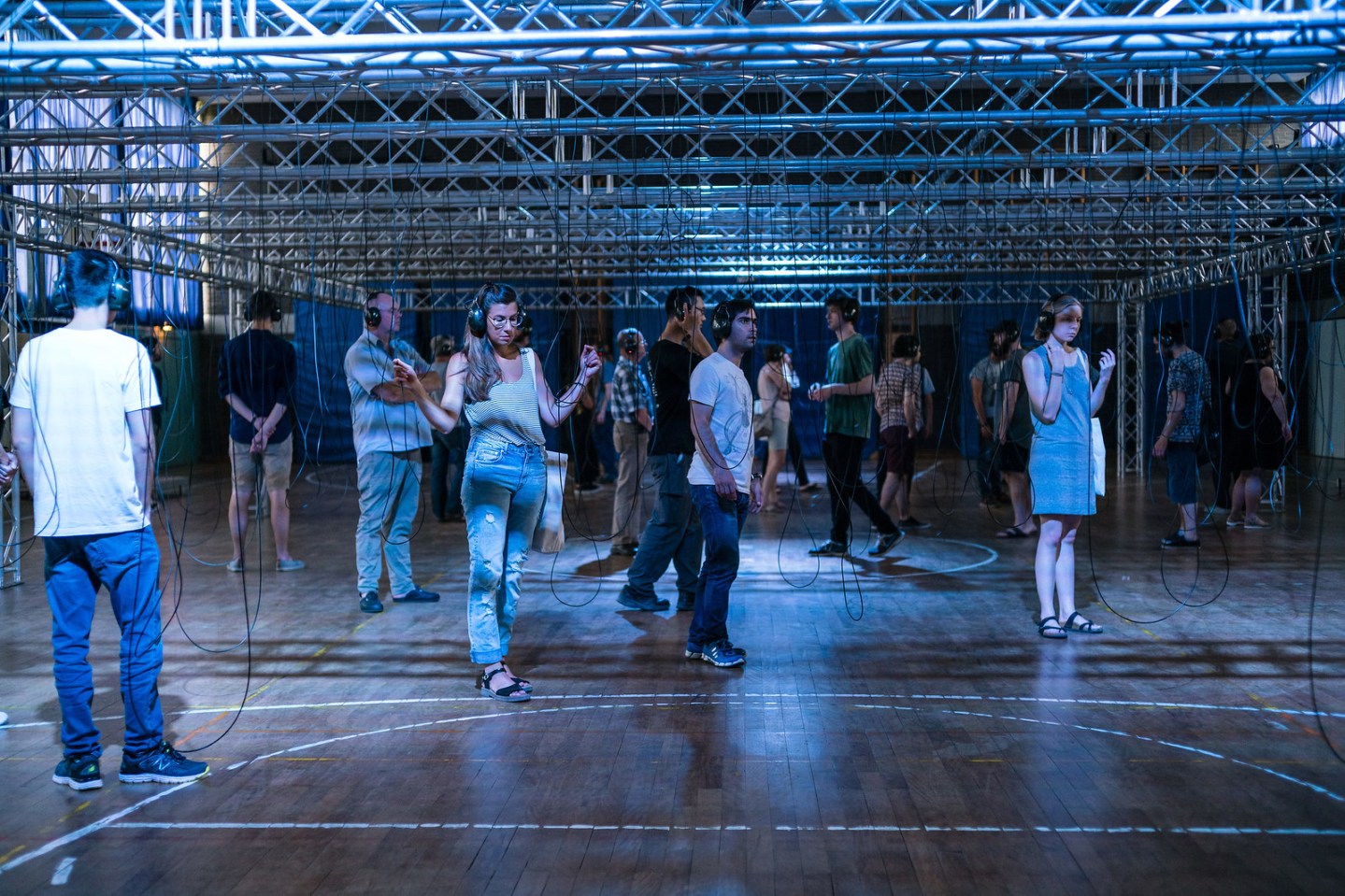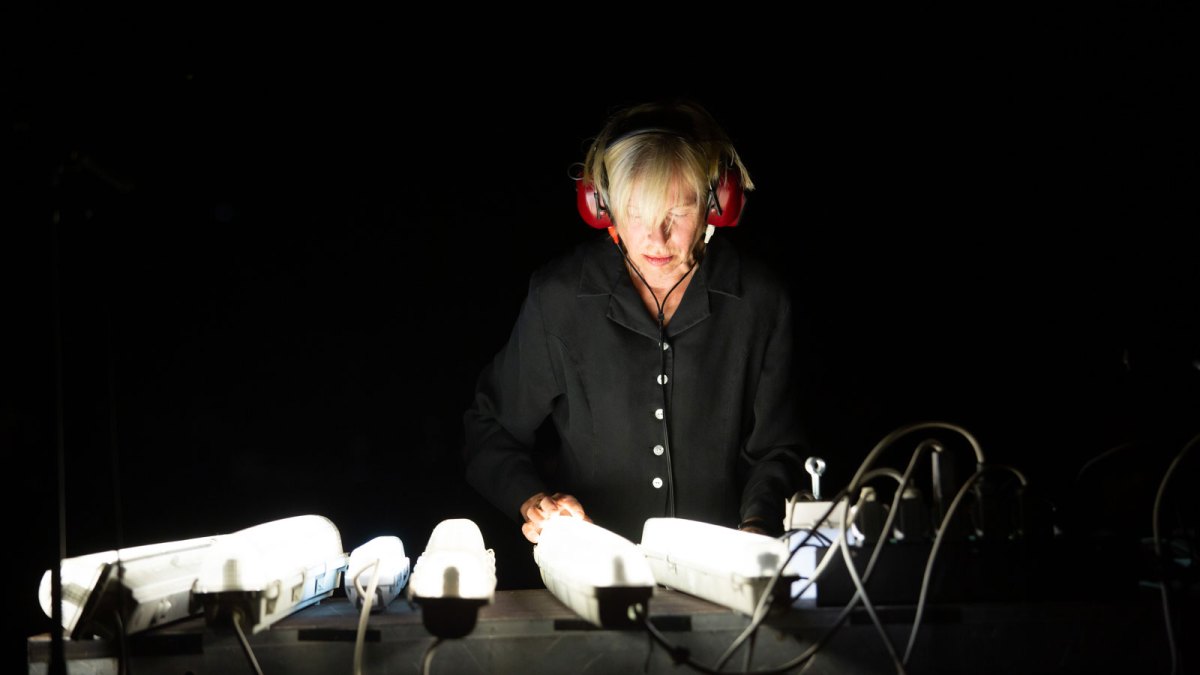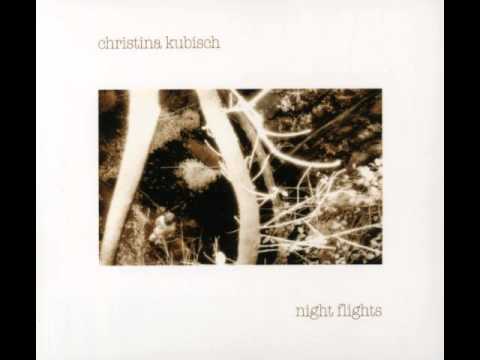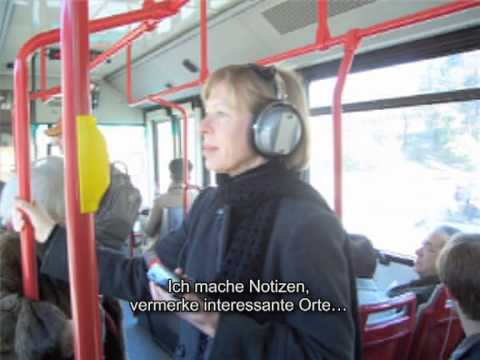Four years ago, I put on a pair of chunky red headphones and was immediately plunged into an entirely new soundworld. Suddenly, everything was buzzing, clicking and pulsing—yet there was no cable running from my headset, no bluetooth link to a nearby media player. I was in the center of Amsterdam for the city’s biennial Sonic Acts festival and had just volunteered to take part in one of Christina Kubisch’s electrical walks through the city. Since 2003, the German artist has been guiding groups of listeners on itineraries through cities from Lagos to Ekaterinburg, Shanghai to Quebec, wearing specially constructed headphones with built-in induction coils for transducing electromagnetic energy into audible sound. Wandering from the De Brakke Grond cultural center to Amsterdam Centraal, the main train station, I could hear the ever-present noise of the dense network of hi-tech security systems which crisscross the modern metropolis: intense throbs emanating from the Louis Vuitton shop’s perfume display, harsh grunts from shop doorways, squeals and growls from cars and cameras everywhere. In just one spot, deep in the Beursplein underground bike garage, far from the sliding doors and automated security systems near the entrance, I found a tiny little oasis of silence. But according to Kubisch, such electromechanical dead zones are now almost extinct—not just in big cities like the Dutch capital but even way out in the countryside.
Born in Bremen in the immediate postwar era, Kubisch first studied painting before attending conservatories in Zurich and Milan as a flutist and composer. Upon graduating, she took classes at the Milanese Technical Institute, where she first discovered the sounds produced by electromagnetic energy by accident, thanks to a small portable telephone amplifier. A pioneering sound artist, her work was included in some of the first major exhibitions dedicated to the new discipline, including “Sound – An Exhibition Of Sound Sculpture” at the Los Angeles Institute of Contemporary Art in 1978 and “Für Augen und Ohren” (For Eyes and Ears) at the Akademie der Künste, Berlin, in 1980. Since then, she has performed and exhibited widely. Her new album, “Plus,” out this spring, is released by Edition DUR, a Berlin label operating out of Dussmann, a gigantic shop selling books, records, scores, and other culture products.
VAN: Your new album “Plus” seems to show a different side to your compositions than we’re used to seeing. Can you tell me a little about some of the techniques at work on this record?
Christina Kubisch: What Dussmann wanted was not the compositions I’m known for, the electromagnetic pieces or installation pieces; they wanted something which is not usually published, something I couldn’t find a publisher for, or a piece which no one is really so interested in. And one thing is, I’ve made a lot of radio plays. In Germany, we still have experimental radio [though such programming is increasingly under threat—Ed.] and I’ve worked with the Hessischer Rundfunk in Frankfurt several times. “Vasenresonanz” [“Vase Resonance”] is based on a collection I have of vases from the ‘50s. I rubbed them, I was singing into them, I put water into them, I put hydrophones in them and re-recorded the sound.

How do you change your approach when composing for radio, as opposed to for a record or concert hall?
Actually not at all. For us composers and musicians, it’s always a chance to do what we want and make a new piece. The people at the radio don’t care, they just want something new. But of course, they’ll say something like, they like it when there’s a voice. They don’t like it when there’s too long of a pause. They don’t like it if something is very silent because then people think the radio doesn’t work… Stuff like that. But so far I have been quite free to do what I want.
What about some of the other tracks on the album?
Well, “Teatime” is about birds. I’m very interested in birds and I have done several installations with real birds and with fake birds. I have a collection of records and I find it so funny when people try to imitate birds so that you can find them when you’re out in nature. They say things like “tea kettle, tea kettle” and stuff like that. I took all these descriptions from birding books and put them together with real bird sounds to have a kind of dialogue. It’s funny that you’re supposed to recognize the birds from these human imitations. Now they probably just have things like that on the internet. No more books.
The disappearance of particular sounds is an abiding theme in your work.
I’m very interested in acoustic things that go away. I have a large collection of electromagnetic sounds which do not exist anymore, because the things that produced them have disappeared. It has a lot of neon tubes, for example. Now they have mostly LED [lights], which sound higher and sharper. The old neon lamps had these magical sounds. I have a whole collection which I made in Asia. Then of course the anti-theft gates in shop entrances: They were very rhythmic—they still are, partly. But now they have ultrasonic sounds which you almost cannot hear; with the headphones they are very sharp and very loud. Everything is getting higher in the digital electromagnetic world and analogue electromagnetic sounds are disappearing. Not all of them, but many. There are fewer old routers and antennas but you hear more 5G instead. I think I’m the only person that has this collection of disappearing sounds. I think they sound quite beautiful.
In 1974–75, you performed a series of “Emergency Solos,” playing the flute with a condom on the end of the instrument or wearing boxing gloves or with thimbles on your fingertips, and so on. What was the initial impulse behind this series of works?
It wasn’t an impulse; it was desperation! I studied the flute and I was a medium-to-good flutist, specializing in new music. I found that, on the one hand, to play that music at that time was so difficult. You had to study hours and hours for just two bars and then it just sounded like it was improvised. I didn’t feel like wasting my time doing that. I also wanted to be more creative than just playing the flute, but at that time, we had no information—we had no internet, none of the communication we have today. So of course, I didn’t really know that I could be a composer. In the States, there were people like Pauline Oliveros, Annea Lockwood, and others. I met them in the middle of the ‘70s. But at that time, I was just lost. So I said, OK. I don’t want to play the flute that way and I won’t be accepted as anything else. So I’ll make it public, in a way—I’ll make public the way people see women playing the flute. So I used thimbles, I used erotic things, I used all the impossible things which hinder you from playing the flute the way you wanted to.
The latest from VAN, delivered straight to your inbox
How did audiences react to these pieces at the time?
That’s interesting because just recently, in the last three years, I’ve given permission for people to play these pieces again. But at the time, people were often really angry with me. At the serious festivals, they said, She just plays like that because she can’t play the flute. But the pieces were quite difficult and quite physically tiring.
What was the most important lesson you learned from your time studying composition with Franco Donatoni in Milan?
I think he was the only composition teacher who was really important for me. What I learned is just: whatever I do, I have to do it seriously and precisely. I can’t say, This is not music or not real composition so I can just do it the way I want and neglect certain things. He always said, even if you do something which is a performance or whatever—we didn’t have a word for sound installation at the time—do it as if you were composing a piece for serious musicians. Don’t waste other people’s time. He was very precise, he drove me crazy sometimes.
It was around this time that you started presenting your work increasingly in art galleries and moving towards the development of sound installations instead of concert pieces. You’ve just said there wasn’t even a word for sound installations then. So where did the idea come from to present your work in this way?
Something like that is never really an idea. It’s a development. It’s part of something you do. I’m not what the Germans call a Rampensau, a “pig which likes the stage.” [Or “attention hog”—Ed.] I wanted to get away from this division between the audience on one side and me on the other. At the same time, in Zurich I studied a lot of ethnographic music from other continents and I saw that music could be part of daily life, while here it seemed so artificial. I’m not against that, but it was not what I wanted. And I started to think, Why can’t there be a room where people can just listen to something, and I don’t need to be there?
What kind of institutions did you find embraced this sort of work first: Those in the art world or in the new music world?
Definitely the art world. The music world [didn’t embrace it] at all. Even in the ‘90s, I was invited to Donaueschingen and [Karlheinz] Stockhausen said, “If these people come now and do sound installations then I won’t come anymore.” And that was the ‘90s! In the art world, there were often some small galleries that were happy for us to experiment, but the museums didn’t want us because sound in a museum takes up space, you can’t just put it away in a corner. I think it started around the late ‘80s when the art world really opened up—the official art world, that is. Mostly it was a group of people who did independent festivals.
What is it that appeals to you about electromagnetic sounds?
Well, they are normally inaudible, so when you listen to them, you see something which is familiar to you and you hear something which is different. Like with film, the interpretation of these two things makes something new in your mind. But they also have a particular quality. There are so many fascinating sounds, like science fiction sounds, rhythmic sounds, ugly sounds, disturbing sounds. And I like the social element. Electromagnetic sounds are always connected to the situation in which people are living. Different countries have different electromagnetic sounds, for example, and different continents have different sounds as well.
How has the electromagnetic signature of our cities changed over the period you’ve been working with these techniques?
The most amazing thing is that there is no more electrical silence. In the beginning, there were sometimes places, like a small white zone in the middle of a city. I would say, Oh shit! I don’t have any electrical sounds here! But now I would love to find more of these places, because it’s almost impossible—not only in big cities, but in the country as well. Almost everywhere you have electromagnetic sound. It’s getting more and more dense. And then of course, there is sometimes a mixture of old and new sounds. I was in Prague recently, and they have a lot of old-fashioned trams and subway systems which sound fascinating. But then they also have shopping centers which are so modern that they have systems I have never heard before. In countries which are globalizing quickly, you can get this mixture of old, more analogue and very digital, high-end sounds. In France, I’ve just come back from Besançon where I did a new Electrical Walk. You have a lot of beautiful sounds there. The people are elegant and they have very elegant electromechanical sounds. When you go to northern countries, sometimes, the sounds are very moderate, a little bit boring. It’s like a portrait of the city for your ears.
Are there any dream projects that you’ve never been able to fully realize?
I have two, and actually one is coming true now. There’s a festival in a German city called the Monheim Triennale, and they’ve made it possible for me to go into an electrical substation. I don’t know what will come out, maybe just a big noise. But it’s something I’ve always wanted to hear very close and not through a fence, hundreds of meters away.
The other thing is connected to an ongoing project which started with this installation of mine called “Cloud.” It’s about cloud storage systems. I’ve only had the possibility of going to two server farms for recording. People don’t want you to get in. One I got into was really a misunderstanding because they thought I would record something different. But it’s so loud when you are in there, and so complex. I think if people knew that their nice cloud has such a heavy and dirty background, they would think about it in a different way. It’s not in the sky, it’s deep in the ground. I would love to make a whole series of pieces about these places. If you know of a server farm you could get me into, please let me know. ¶
Correction, 5/16/2023: A previous version of this article included an incorrect caption for Kubisch’s concert installation “Orchestra on a Wire.” VAN regrets the error.
Subscribers keep VAN running!
VAN is proud to be an independent classical music magazine thanks to our subscribers. For just over 10 cents a day, you can enjoy unlimited access to over 875 articles in our archives—and get new ones delivered straight to your inbox each week.
Not ready to commit to a full year?
You can test-drive VAN for one month for the price of a coffee.



